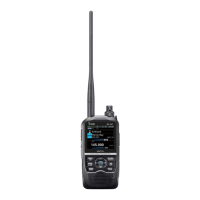11
REPEATER AND DUPLEX OPERATIONS
11-3
FM Repeater operation
DChecking the Repeater input signal
You can check whether or not that another station’s
transmit signal can be received directly (not through a
repeater), by listening to the repeater input frequency.
Hold down [SQL] to listen on the repeater input
frequency.
D1750 Hz tone burst
A 1750 Hz tone is required to access many European
repeaters.
For the ID-52E only
Push [PTT] briefly and release, and then hold down
[PTT] to transmit a 1750 Hz tone burst signal.
1. Push [MENU].
2. Select “DTMF/T-CALL” in the “SET” menu.
3. Select “DTMF Memory.”
4. Select “T-CALL.”
5. Push [MENU] to exit the MENU screen.
6. Rotate [DIAL] to set the frequency received from a
repeater.
7. Set the offset frequency and the duplex direction.
(p. 11-4)
• The duplex icon is displayed.
8. While holding down [PTT] to transmit, push [SQL]
to transmit a 1750 Hz tone signal.
• Accesses the repeater with a short tone burst.
9. Operate in a normal way.
L In the same way as a simplex call, alternately
transmit and receive.
L Information
• While monitoring, the status indicator lights green, and an
S/RF meter dot blinks.
• While monitoring, the displayed frequency automatically
changes to the transceiver transmit frequency (repeater
input frequency).
• When the other station’s signal can be directly received,
move to a non-repeater frequency, and use simplex.
(Duplex OFF)
Display while monitoring

